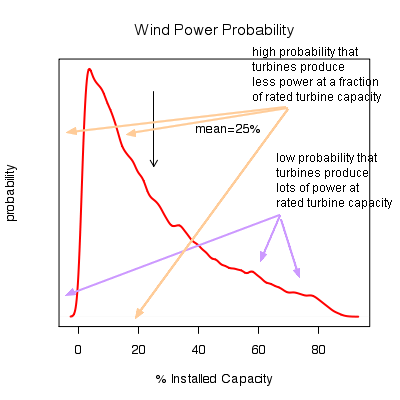Wind Energy Information Group Predicts 'A NAMA For Wind Turbines!'
 national |
environment |
other press
national |
environment |
other press  Thursday November 07, 2013 22:23
Thursday November 07, 2013 22:23 by T
by T
The plan for a huge number of wind turbines is not just running into trouble. It seems it could turn out to be a bit of a white elephant. The drive is coming from the UK because the population density is so high they are running into continual problems with objections and as a result they are unable to meet their own promised obligations for the percentage of renewable energy. But they have done a deal with the Irish government to use the 'empty' midlands of Ireland to build thousands of wind turbines and transfer the power by cable to the UK.
To many these seems like corporate colonialism and the though of all the billions in investment with the chance to then quickly sell complete wind farms on has all the worst kinds of people involved and the Irish government and their friends have been so eager to get hands on this that the Irish government has incredibly not even carried out a Cost Benefit Analysis of the whole thing.
With wind farms if the site is not windy enough and too many turbines are put on the site, it can result in a situation where they do not meet the targets for power output and hence revenue and it can result in the venture not covering its costs properly -i.e. making a loss. This has happened quite a bit in the interior locations of various countries as the strongest and most consistent wind generally occurs on coastal sites. And Colm McCarthy, the ‘Bord Snip’ economist, has already described the drive to build wind farms all over Ireland as another potential ‘Nama’.
The news that we could end up with a NAMA for Wind Farms in the Midlands was reported today in the Midland Tribune.
The opening paragraph says
Kilcormac/Kinnitty/Cadamstown Wind Energy Information group has expressed the view that Ireland will soon need a NAMA for wind turbines, if proposals to erect hundreds of wind turbines in the Midlands go ahead.
Responding to the publication of the Bord na Móna's Chief's comments in last week's Tribune that Offaly will be the Saudi Arabia of wind energy if their Clean Energy Hub projects go ahead, the Group has yet again called on the Government to demonstrate that its Wind Energy Policy fulfills the three Pillars of Sustainability in Planning terms i.e. Environmental, Economic and Social.
In a statement the group said 'It is inconceivable that the CEO of Ireland Inc is intent on pressing ahead with its unsustainable wind energy policy without even having carried out a Cost Benefit Analysis from the outset! Has Minister Rabbitte not looked across the water to Scotland where they are in danger of blackouts before the end of the century due to the Scottish Government's massive investment in Wind Energy without also having done the costings and also having ignored other forms of renewables. Colm McCarthy has said that Ireland will soon have a NAMA for wind turbines.'
The report then goes on to mention some of the usual anti-wind arguments although I do not think it is quite straight forward but in this particular case, I think the final comment really sums up the situation
This project is all about profit at the expense of our quality of life. That's it. Money!'
And what this encapsulates is that in all these cases where we are trying to solve a problem -in this case energy supply and reducing CO-2, there are always people and large business who are willing to use and abuse this concern and public support to run roughshod over people and to make a killing for themselves and the people who cleared the institutional obstacles to allow them to do it.
You can read the full report at the link below



Comments (3 of 3)
Jump To Comment: 1 2 3The following from the Roscommon People (today) is also relevant to the above and lists some of the locations where "developers" are considering placing turbines. People have a limited time to object.
Sites in Elphin, Ballaghaderreen, Scramogue, Arigna, Cloonfad and Brideswell have been deemed viable for wind energy development in Roscommon County Council’s Draft Wind Energy Policy and the closing date for submissions on the policy is February 28th.
A spokesperson for Sliabh Ban Community Group said that it is important that Roscommon people read the draft policy, because once it is accepted by Roscommon county councillors, it will guide developers as they seek to profit from future wind turbine sites in Co. Roscommon. As it stands, large areas of County Roscommon are being described by the draft policy as suitable for wind turbines.
The Draft Wind Energy Policy puts forward the following areas as being viable for wind energy development:
Elphin Drumlins;
Ballaghaderreen and Bockagh Hills Uplands;
Sliabh Ban and Boerish Bogland;
Scramogue River Basin;
Lough Funshinagh and Stone Wall Grasslands and Esker Ridges;
Arigna Mountains; Skrine Hill and Limestone Pavement;
Mid Lough Ree Pastureland;
Ballinlough Bogland and Esker Ridges;
Cloonfad Hills and Esker Ridges;
Cloonfad Bog and Upland;
Mulaghnashee Wet Farmland Plateau;
Cloona Lough and Lung River Bogland Basin;
Brideswell Esker Belt
The report also added some specifics for two of the locations:
The Draft Wind Farm Strategy is available for inspection at the County Council Planning Office on Golf Links Rd. It also can be downloaded from the Internet on the Roscommon County Council website www.roscommoncoco.ie ....but it is quite hard to find so it has been downloaded and attached here too. See page 35 for the list of sites.
Full text at link below